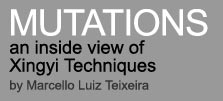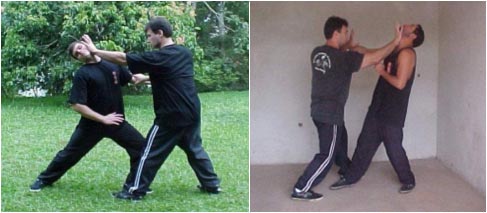 |
 In spite of what many people imagine, the definition of the slightness for internal style is not applied to Xing Yi Quan. Of predominantly aggressive feature, this martial art has its great goal the work of Chi Kung incorporated to the movements. Kept in secret for that it has its domain, taught in its full form only to few disciples, the Xing Yi is much more of that the five fists (five elements) and the twelve animals as it comes being spread out. I will clarify some important points in relation to this subject, so that the people can have a wide and real notion of the style. |
 Basic Pi Quan ad two kinds of mutations |
Each one of the five fists in its basic form is the expression of a force.
In its advanced form, a variety of mutations that are, in the reality
exists for each fist, these same basic, trained and applied forces in
diverse methods. I cite as practical example, the movement Pi Quan that
represents the energy of the metal and has the intention to crack and
to cut. This movement in its basic form in the branch of Shanxi is represented
in the idea of an axe cutting something and executed with the attacking
hand closed. However, in the Hopei branch, the hand, that it attacks,
remains open in palm form. Even so internally the intention is the same
one. Into its advanced form the movement that represents the energy of
the metal transforms into diverse others techniques, being able, for example,
to use the palm or forearm as way to apply the force. Despite the external
variations of the movement, the internal intention, to crack or to cut,
is kept.
The
metal's intention of cracking in three ways of applications |
||
| Tiger technique in a direct palm strike. | Pi Quan in a cutting forearm technique. | Dragon technique in a descending palm strike |
In
the practice of the twelve animals this is evidenced well, a time that
in the animals themselves we find mutations of the five basic fists. As
an example, the Tiger and the Dragon, that use the same force of the Pi
Quan. It's valley to detach here, that the twelve animals also present
its variations in form and method of trainings. Not only in relation to
the origins of each branch of Xing Yi Quan, but also in the emphasis that
each master gave in its personal training and the one of the direct disciples.
In our School (kwoon), before initiating the study of the twelve forms
it is necessary the full domain of the five movements and its intentions,
a time that in the twelve forms these forces are gifts. It is necessary
to stand out that even with the different physical representation, the
internal expression (intention) of the five movements always is kept.
We give below examples relationed to the Tiger and the Dragon techniques.
 Tiger Technique   Dragon Technique |
Wrongly defined by those who do not know the completeness of this martial
art, as a strict linear style, the Xing Yi Quan in its proper universe
of techniques, offers options for any circumstance lived in a real combat.
Mechanically
the style functions on the following way. When executing a blow, the mind
anticipates the movement (intention), making the body to execute it. This
force is generated in an only movement of single grain structure and its
great impact is possible, thanks to a peculiar system of coordinations
that characterize the proper style (feet - hands, shoulder - hip, elbow
- knee). We can say then, that the feet and the hands always arrive together.
When hitting, the hand reaches the adversary together with all the body,
making that the target receives, the impact of not only the fist beating
him, but of all the structure in set.
Old texts describe great fighters of Xing Yi, as being example of practitioners
of one technique alone, what it is an error of interpretation. It counts
the history that the Master Guo Yun Shan was a specialist in Beng Quan
and my master always emphasized that the Master Ch'e I Zai trained a lot
the Pi technique. It is an error that many people think that these masters
of the past were specialists of one movement. They were specialists yes,
not only in a movement, but in the use of this force.
As I said before, each fist (element) develops a force (movement / external)
and an energy (intention / inner) that it can be applied in many forms
through innumerable mutations techniques (applications in combat).
by
MARCELLO LUIZ TEIXEIRA
Rio de Janeiro, Brazil, December of 2001.
Marcello's website:
XING YI CHUEN